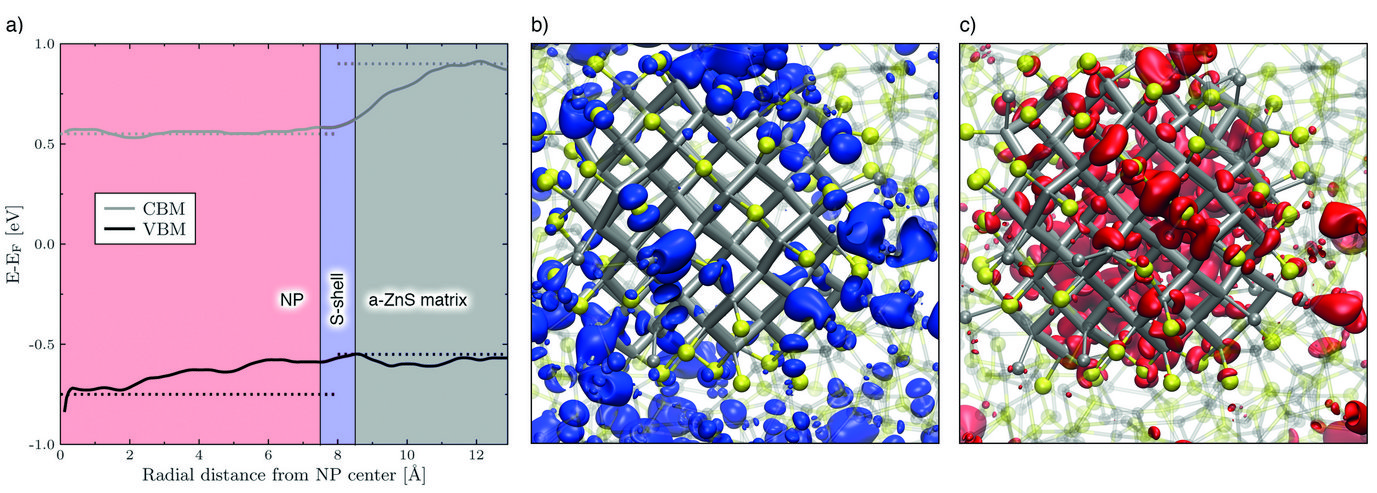Nanostructured solar cells: Tailored semiconducting nano-composites as optimized light absorbers
By precisely controlling the size and shape of nanoparticles (NPs), their surface chemistry, arrangement into superlattices and insertion into a suitable host matrix, one can create semiconducting nano-composites with specifically tailored electronic, optical and mechanical properties. Bulk silicon for example has a band gap of 1.1 eV and is an indirect semiconductor, effectively preventing its application as a light emitter. Silicon nanoparticles on the other hand exhibit radically different properties, featuring efficient photoluminescence. The band gap becomes a function of the NP diameter, allowing for light emission over a wide range of colours. Such NPs can be inserted into a host matrix to achieve efficient charge transport and create durable nano-composites.
Nano-composites also allow integrating complex functional properties into a single material. The Coulomb interaction is strongly enhanced, due to the quantum confinement of the electrons into the small space of the NPs. With respect to solar energy conversion, this enhanced Coulomb interaction can drive a process called multi-exciton generation (MEG), where one incoming solar photon creates several electron-hole pairs instead of just one. Utilizing MEG enables in principle to build single junction solar cells that exceed the shockley-Queisser limit in solar energy conversion efficiency of 31%.
Recent advances in wet chemical techniques allow for the synthesis of NPs, their assembly into super-lattices and embedding into a host matrix using only inexpensive solu-tion processing. However, the atomistic and structural details of such composites are poorly understood, due to the complexity of the synthesis conditions and the unavailability of robust experimental techniques to probe nanointerfaces at the microscopic level. For device applications a detailed understanding of the atomistic structure and its link to the resulting composite properties is required.
Starting January 2014, the Atomistic Modelling Group has been awarded a “NanoMatFutur” grant from the German Federal Ministry for education and research (BMBF). Over the course of 4 years, we systematically investigate technologically relevant nano-composites to build a detailed understanding of their structure and explore new ways to tune their properties.
A major roadblock to utilizing MEG in device applications is the band gap problem: the same quantum confinement which enables efficient MEG enlarges the band gap, shifting the onset of MEG beyond the solar spectrum. One needs simultaneous-ly strong quantum confinement and small band gaps on the order of 0.5 eV. Silicon and Germanium both feature metastable high pressure phases called BC8 and st12, respectively, much like diamond is a high pressure phase of carbon. We demonstrated from ab initio many-body perturbation theory calculations that NPs with such high pressure core structures exhibit simultaneously low band gaps and strongly increased MEG rates. The concept of creating NPs with core structures made from allotropes of elemental semiconductors is introduced as a new way of tuning the properties of nano-composites. Recent expe-riments demonstrate the successful synthesis of NPs with BC8 and ST12 core structures from chemical solution processing.

Silicon nanoparticles (NPs) embedded in amorphous zinc sulfide feature charge sepa-rated transport channels:
a) Shows the valence and conduction band edges inside the NP, in the interface region (S-shell) and inside the matrix.
b/c) Structural model of a Si NP with a diameter of 1.6 nm. Blue/red isosurfaces denote the spatial distribution of valence/conduction band edge states, respectively. The valence band is delocalized throughout the matrix, whereas the conduction states are localized within the NPs.
To allow for efficient charge transport the NPs are embedded in a host matrix. First principles molecular dynamics and simulated annealing were used to obtain structural models of SI NPs embedded in amorphous zinc sulfide. By using large-scale many-body perturbation theory calculations we demonstrate that this system features a so-called type II band alignment, which is highly desirable: the conduction states are localized within the NPs, whereas the valence states are delocalized throughout the matrix. Such an alignment between the NP and matrix states is a prerequisite to obtain efficient band-like charge transport. Presently, we are calculating phase diagrams for solution processed nano-composites, where both NP synthesis and matrix embedding has been performed by wet chemistry. A multitude of structures possibly realized at the NP surface is considered, such as surface termination, reconstructions, passivation, oxidation, substitution of subsurface atoms, ligand dissociation, core-shell formation and the adsorption of the ligands on NPs with different structures. This study provides guidance about the experimental conditions which lead to specific structural motifs and is expected to lead to a detailed understanding of the structural properties of nano-composites.
Author: Stefan Wippermann
